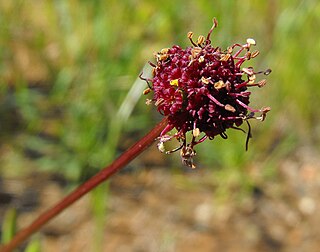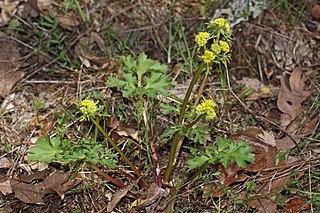
Ageratina altissima, also known as white snakeroot, richweed, or white sanicle, is a poisonous perennial herb in the family Asteraceae, native to eastern and central North America. An older binomial name for this species is Eupatorium rugosum, but the genus Eupatorium has undergone taxonomic revision by botanists, and a number of the species that were once included in it have been moved to other genera.

Sanicula marilandica, the Maryland sanicle or Maryland black snakeroot, is a flowering plant widespread in North America but rare along the Pacific coast of the continent and Texas. Sanicula marilandica is listed as Sensitive in Washington state.

Sanicula europaea, the sanicle or wood sanicle, is a perennial plant of the family Apiaceae.

Sanicula arctopoides is a species of sanicle known commonly as footsteps of spring, bear's foot sanicle or yellow mats. It is a perennial herb found on the west coast of the United States, especially near the ocean. The branches are short and thick and may be prostrate or slightly erect. The leaves are yellowish-green and carrot-like or maple-shaped, and the tiny yellow flowers are borne in umbels with prominent bracts. The plants grow in low matted patches along the ground, resembling "footsteps" of yellow against the background.

Sanicula is a genus of plants in family Apiaceae, the same family to which the carrot and parsnip belong. This genus has about 40 species worldwide, with 22 in North America. The common names usually include the terms sanicle or black snakeroot.

Sanicula bipinnata is a species of plant in the family Apiaceae known by the common name poison sanicle. It is endemic to California where it is found in low-elevation mountains and foothills, especially in the hills along the coast. It occurs in the California Coastal Range and Sierra Nevada foothills, including Ring Mountain, California.

Ageratina herbacea is a North American species of flowering plants in the daisy family known by the common names fragrant snakeroot and Apache snakeroot. It is native to desert regions of the southwestern United States and northern Mexico. It grows in rocky slopes in conifer forests and woodlands.
Sanicula laciniata is a flowering plant species of in the family Apiaceae. Common names include coastal blacksnakeroot, laceleaf sanicle, and coast sanicle.

Sanicula arguta is a species of flowering plant in the family Apiaceae known by the common names sharptooth sanicle and sharptooth blacksnakeroot.

Sanicula bipinnatifida is a species of flowering plant in the parsley family known by the common names purple sanicle, purple blacksnakeroot, and shoe buttons. It is native to the west coast of North America from British Columbia to Baja California, where it can be found in many types of habitat, including grassland, woodlands, and mountain slopes of serpentine soils. It is a perennial herb growing to a maximum height near 60 centimeters from a taproot. It is bright green to dark purple in color. The leaves are borne on long petioles, measuring up to 19 centimeters long with blades divided into several toothed lobes. The inflorescence is made up of one or more heads of bisexual and male-only flowers with tiny, curving, reddish, purple, or yellow petals. The prickly fruits are a few millimeters long.

Sanicula crassicaulis is a species of flowering plant in the family Apiaceae known by the common names Pacific blacksnakeroot and Pacific sanicle. It is native to the west coast of North America from British Columbia to Baja California, where it can be found in many types of habitat, including mountain slopes, grassland, and woodlands. It is a perennial herb producing a thick stem up to 1.2 meters tall from a taproot. The leaves have blades up to 12 centimeters long which are divided into a few deep lobes and edged with small teeth. The inflorescence is made up of one or more heads of bisexual and male-only flowers with tiny, curving, yellow petals. Each head has approximately five leaflike, lance-shaped bracts at its base. The rounded fruits are a few millimeters long, covered in curving prickles, and borne in small clusters.

Sanicula graveolens is a species of flowering plant in the family Apiaceae known by the common names northern sanicle and Sierra blacksnakeroot. It is native to western North America from British Columbia to Montana to California, and southern South America, including southern Chile. Its habitat includes mountain slopes, forests, and woodlands on serpentine soils. It is a perennial herb producing a slender, branching stem up to half a meter tall from a taproot, with leaves alternate. The lowest leaves have long stalks and are often attached below ground. The upper leaves are smaller, sparse and often sessile. The leaves are compound, the blades each divided into three deeply lobed, toothed leaflets. The herbage is green to purple-tinged to all purple in color. The inflorescence is made up of one or more heads of bisexual and male-only flowers with tiny, curving, yellow petals. Each head has an array of narrow, toothed bracts at its base. The rounded fruits are a few millimeters long, covered in curving prickles, and borne in small clusters.
Sanicula hoffmannii is an uncommon species of flowering plant in the family Apiaceae known by the common names Hoffmann's blacksnakeroot and Hoffmann's sanicle. It is endemic to California, where it is known from the Channel Islands and a few locations in the coastal mountain ranges of the mainland, including the Scott Creek watershed in Santa Cruz County. Its habitat includes coastal hillsides and mountain slopes, sometimes with serpentine soils. It is a perennial herb producing a thick stem up to 90 centimeters tall from a taproot. The green or bluish leaves are compound, the blades each divided into about three lobed, toothed leaflets. The inflorescence is made up of one or more heads of bisexual and male-only flowers with tiny, curving, yellow-green petals.
Sanicula peckiana is an uncommon species of flowering plant in the family Apiaceae known by the common names Peck's blacksnakeroot and Peck's sanicle. It is native to the Klamath Mountains of southern Oregon and far northern California, where it grows in chaparral and woodland habitat, often on serpentine soils. It is a perennial herb growing to a maximum height near 40 centimeters. The leaves are simple or divided into a number of lobes, the edges generally with sharp teeth. The inflorescence is made up of one or more heads of bisexual and male-only flowers with tiny, curving, yellow petals. The fruits are borne singly or in heads of up to five, each fruit covered in bumpy tubercles and sometimes with prickles near the tip.
Sanicula saxatilis is a rare species of flowering plant in the parsley family known by the common names devil's blacksnakeroot and rock sanicle.

Sanicula tracyi is a species of flowering plant in the family Apiaceae known by the common names Tracy's blacksnakeroot and Tracy's sanicle. It is endemic to northwestern California, where it is known from woodlands and coniferous forest in hills and mountains. It is a perennial herb producing a slender stem up to about 60 centimeters tall from a taproot. The leaves are compound, divided into usually three leaflets which are deeply cut into lobes and serrated along the edges. The herbage is green to purple in color. The inflorescence is made up of one or more heads of bisexual and male-only flowers with tiny, curving, yellow petals. The fruits are 2 or 3 millimeters long, each fruit covered in bumpy tubercles and sometimes with prickles near the tip.

Sanicula tuberosa is a species of flowering plant in the family [[Apiaceae|parsley family] known by the common name turkey pea. It is native to western North America from Oregon through California to Baja California, where it can be found in many types of habitat, including chaparral, forests, and woodlands. It is variable in appearance. In general, it is a perennial herb producing a slender stem up to 80 centimeters long from a small, spherical tuber no more than 2 centimeters wide. The leaves are compound, divided into usually three leaflets which are smooth or deeply cut into lobes. The herbage is green to purple in color. The inflorescence is made up of one or more heads of bisexual and male-only flowers with tiny, curving, yellow petals. The fruits are 1 or 2 millimeters long and covered in bumpy tubercles.
Sanicula mariversa is a rare species of flowering plant in the family Apiaceae known by the common name Waianae Range black-snakeroot. It is endemic to Hawaii, where it is known only from the Waianae Mountains on the island of Oahu. It is threatened by the degradation of its habitat. It is a federally listed endangered species of the United States.
Sanicula purpurea is a rare species of flowering plant in the carrot family known by the common names purple-flower black-snakeroot and purple-flowered sanicle. It is endemic to Hawaii, where it is known from Maui and from the Koolau Mountains on the island of Oahu. It is threatened by the degradation of its habitat. It was federally listed as endangered species of the United States in 1996.

Orbexilum pedunculatum, commonly known as Sampson's snakeroot, is a species of flowering plant in the legume family. It is native primarily to the Southeastern United States where it is found in prairies and savannas, often in acidic soil. It is a perennial that produces racemes of flowers in early summer.














